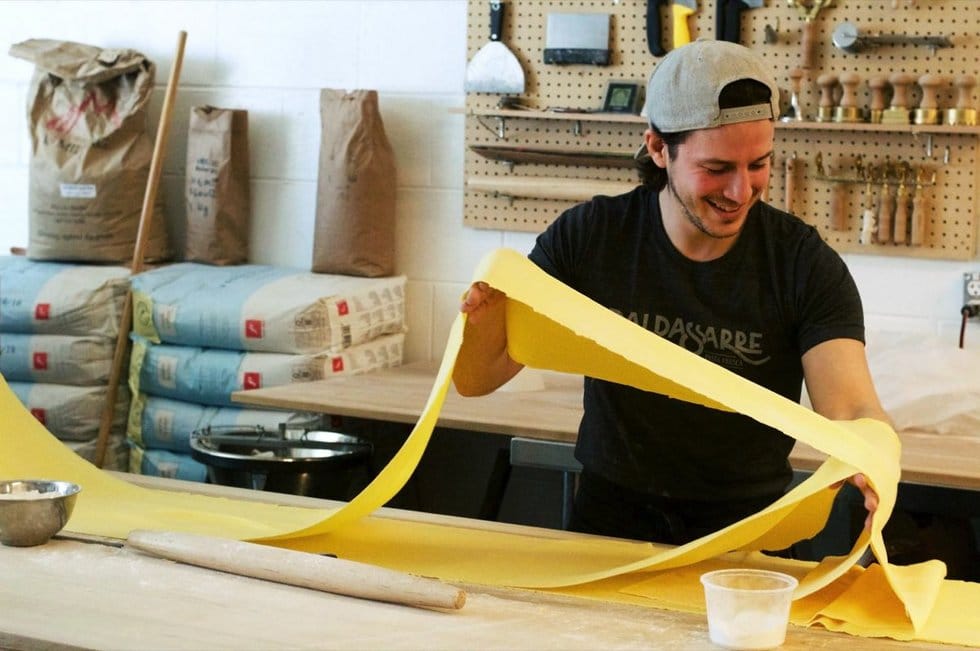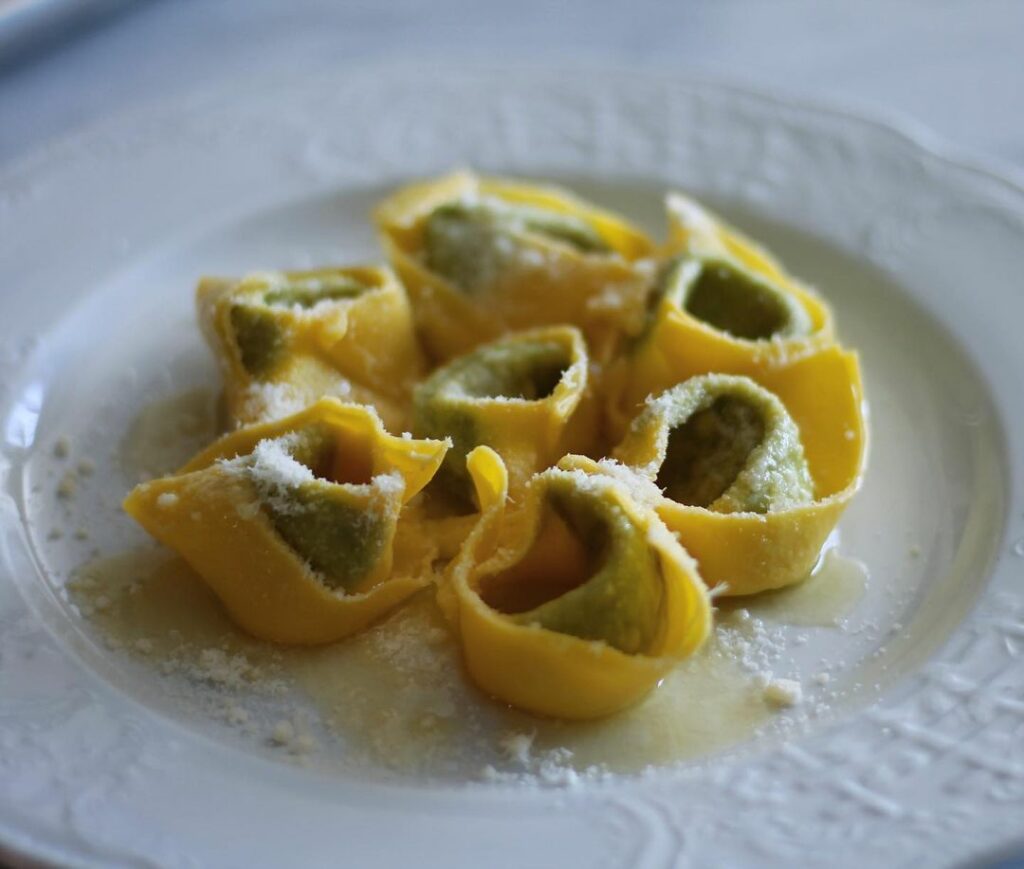On Geary Avenue in Toronto, you can get some of the city’s best fresh pasta, piping-hot and tossed with simple housemade sauce, handed to you from the front window of an unassuming industrial factory building. (Pro tip: Look for the Italian flag planted out front.)
Famiglia Baldassarre, a wholesale business-turned-pasta counter, is the creation of Leandro Baldassarre, who became Toronto’s premier pastaiolo almost by chance after launching his career at Toronto dining destinations like Nota Bene and acclaimed kitchens around the globe.
Though Leandro started out intending to only supply other restaurateurs with their tagliatelle and ravioli, Famiglia Baldassarre’s claim to fame has become it’s lunchtime pasta service — which was originally as a closely-guarded secret among local diners, due to a law that technically made it illegal for Baldassarre to serve pasta to-go.

We sat down with Leandro Baldassarre of Famiglia Baldassarre in their front garden to talk about how Italian culture influenced his cooking, how the restaurant balances traditional DOP products with homegrown produce, and how those just-for-fun, break-even lunches became a vital lifeline during COVID-19.
When did you know you wanted to focus on pasta?
Right before I started Famiglia Baldassarre, I had been working at a restaurant called Dal Pescatore, this incredibly beautiful restaurant in the middle of nowhere in Mantova. They were elevating country food to a level where people would literally get into a helicopter just to eat there.
Back then, my mission was to just go Michelin as much as I could, but while I was there, working in a three-Michelin-star restaurant, I ultimately realized that was what I didn’t really want. We’d be doing these really fancy plates — but part of my shift was also feeding chickens, or mending a fence. All the stuff that was happening around that kitchen shift — the culture, the lifestyle, the traditions — really changed the way I cook.
I got back to Toronto and David Lee, who I’d apprenticed under, had a space to rent. He’s like, “Make some pasta, bring it to Nota Bene, we’ll try it out.” It became a menu item, then a couple menu items, more restaurants put in orders, one thing led to another. It just snowballed. Eventually I looked back and was like, “I guess I’m a pasta maker now.”
You had to serve pasta in secret for a long time — how did that come about?
A while after moving the wholesale business to Geary, I thought, “I miss cooking. Why don’t we just cook some pasta, advertise to people in the building, and have a few people come in?”
I went to apply for a restaurant license, and that turned into a whole ordeal because there’s a Geary bylaw from the ‘90s that put a prohibition on restaurants. For a year, we got around it by having a “donation-based” lunch situation where we issued people membership cards, and people came and “donated” for their meal. It started off as five or 10 people coming for lunch, and no one really paid attention — until the next thing you know, there’s like a lineup of 50 people outside.
Eventually we got our license, and it was all fully legit — and here we are, four years later.
Has the vibe of your lunch services changed now that you’ve “gone legit”?
It has — for different reasons. It’s gotten busier. But the only thing that’s really changed has had more to do with COVID.
We still cook what we want to cook. That was the whole idea with lunch — it wasn’t supposed to be a money making thing, right? It was like, “Wouldn’t it be so cool to serve tagliatelle with butter and truffles for $25?” That’s a break-even, but who cares? But with COVID, we lost all our wholesale clientele with the snap of a finger. So it was like, OK, now we need to rely on the public.

How much of what you serve comes from traditional Italian recipes, and how much do you and your staff come up with?
I would say 95% of it is traditional stuff that we really love. It’s also a way to have teaching moments with my staff. Like, “Okay, guys, ever had pisarei e faśö? It’s this super wicked old-school dish from Piacenza,” and then we all get together and make it.
Some dishes are a little loose on tradition, but they’re very much based in it. Today we did burrata-filled tortellini with two sauces: One was a saffron butter and one was an anchovy-tomato sauce. That’s me going: “If I were in Abruzzo right now, at a restaurant that wasn’t ultra-traditional, what would I be eating?” They love using saffron; they’re not too far from Puglia, so you’ll see burrata; they’re close to the coast, so anchovies get used a lot; they have fresh tomatoes at the end of the summer. Even if we get creative with dishes, it’s still very much rooted within the fundamentals.
You make a point to stock IGP and DOP products in the grocery part of the store, and use them in your kitchen. Could you tell us about why you’re committed to offering them, and what you keep in stock?
There are certain things that I’m so loyal to, and a lot of those are DOP products. A DOP product just gives you faith — if this Parmigiano Reggiano or salame is marked DOP, it was made to a certain level, and you’re gonna get certain specific characteristics.
Some of my favourite products we carry are our salumi and Prosciutto di Parma. We have the 16-month prosciutto right now; it’s one of my favourites. The salame piacentino — incredible. As soon as I tried it, we started buying cases of the stuff. We were serving it on our menu before COVID — then we started selling them retail, and people buy them like crazy.
And obviously there’s the cheese, pecorino romano and Parmigiano Reggiano — we just bring in wheels and wheels and it just moves. We use it for pretty much everything.
Using those products is also a way for me to connect to those Italian flavours. Taking these imported goods and putting them together with the fresh ones produced locally really makes it, I would say, Italian-Canadian cuisine.
How do you negotiate the balance between using these imported Italian ingredients and bringing in more seasonal, local things?
It can be hard to bring in produce. That’s one of the things I learned while working in Italy. I grew up southern Italian, which means tomatoes, garlic, all these kind of hot-weather items. Cooking in the north in the winter, I felt like I was living in Canada, in terms of the climate. We were eating cabbage and pork and apples that were cellared. I was like, “This is what we have in Canada — yet in Canada, we’re so focused on eating a Caprese salad in the middle of December.” It’s like — why?
I like to keep my produce local, because that actually makes me cook more traditionally. When you combine that produce with those DOP ingredients, then you have, I think, the optimal situation. A Caprese and a big plate of Prosciutto di Parma DOP at the end of summer, or a tagliatelle packed with Parmigiano Reggiano in the winter — those are the real beauty combinations. You take the produce we have here that’s of the season, then add those more shelf-stable DOP products that are made at such a high level where it’s like, “Why try to make your own?”
One of the things I love about Famiglia Baldassarre is how willing you are to add in little threads of Italian culture that don’t necessarily just tie into food — right down to throwing a Sagra event with your own knockoff poster.
I think that goes back to having the wholesale business — one that can bring in consistent income. It allows me to do everything else with much more freedom. Everything I make, funny enough, I feel like I’m selling it to myself: What do I want to buy? What do I want to eat? That might seem self-centred, but at the end of the day, I want to do stuff where I would be ecstatic to walk into this business and have this experience.
The Sagra — I don’t know how many sagras I’ve been to. I can’t even count. I’d been talking for years about throwing one; finally, we threw it together in like a month and had like 1200 people show up. It was crazy. People have been asking me to throw another one, but the energy is not there. I want people drunk and dancing and hugging each other.
The compliments that always send me over the moon, that make my week, are like, when some older Italian person will come in and be like: “Signore. I tortellini? Eccezionali.” Like, that’s what I’m doing it for. I’m doing it for Italians.



Add a comment